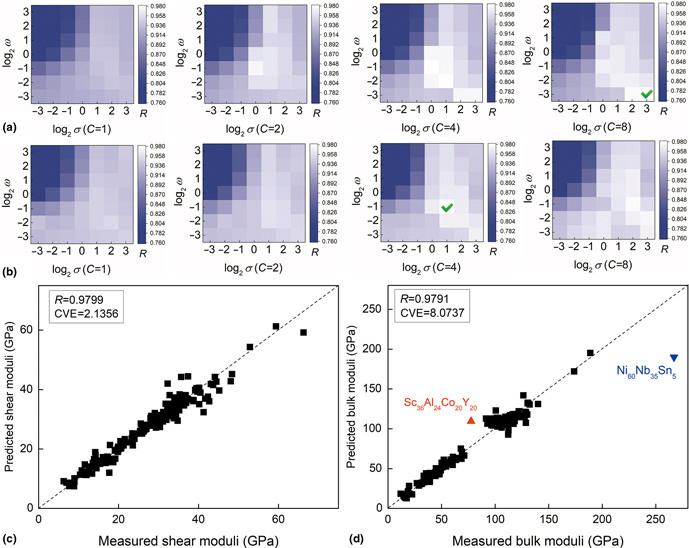Crossref Citations
This article has been cited by the following publications. This list is generated based on data provided by
Crossref.
Xiong, Jie
Shi, San-Qiang
and
Zhang, Tong-Yi
2020.
A machine-learning approach to predicting and understanding the properties of amorphous metallic alloys.
Materials & Design,
Vol. 187,
Issue. ,
p.
108378.
Liu, Xiaodi
Li, Xin
He, Quanfeng
Liang, Dandan
Zhou, Ziqing
Ma, Jiang
Yang, Yong
and
Shen, Jun
2020.
Machine learning-based glass formation prediction in multicomponent alloys.
Acta Materialia,
Vol. 201,
Issue. ,
p.
182.
Deng, Binghui
and
Zhang, Yali
2020.
Critical feature space for predicting the glass forming ability of metallic alloys revealed by machine learning.
Chemical Physics,
Vol. 538,
Issue. ,
p.
110898.
Xiong, Jie
Shi, San-Qiang
and
Zhang, Tong-Yi
2021.
Machine learning of phases and mechanical properties in complex concentrated alloys.
Journal of Materials Science & Technology,
Vol. 87,
Issue. ,
p.
133.
Mukhamedov, B. O.
Karavaev, K. V.
and
Abrikosov, I. A.
2021.
Machine learning prediction of thermodynamic and mechanical properties of multicomponent Fe-Cr-based alloys.
Physical Review Materials,
Vol. 5,
Issue. 10,
Zhang, Y.X.
Xing, G.C.
Sha, Z.D.
and
Poh, L.H.
2021.
A two-step fused machine learning approach for the prediction of glass-forming ability of metallic glasses.
Journal of Alloys and Compounds,
Vol. 875,
Issue. ,
p.
160040.
Choi, Eunseong
Jo, Junho
Kim, Wonjin
and
Min, Kyoungmin
2021.
Searching for Mechanically Superior Solid-State Electrolytes in Li-Ion BatteriesviaData-Driven Approaches.
ACS Applied Materials & Interfaces,
Vol. 13,
Issue. 36,
p.
42590.
Feng, Shuo
Fu, Huadong
Zhou, Huiyu
Wu, Yuan
Lu, Zhaoping
and
Dong, Hongbiao
2021.
A general and transferable deep learning framework for predicting phase formation in materials.
npj Computational Materials,
Vol. 7,
Issue. 1,
Schultz, Lane E.
Afflerbach, Benjamin
Francis, Carter
Voyles, Paul M.
Szlufarska, Izabela
and
Morgan, Dane
2021.
Exploration of characteristic temperature contributions to metallic glass forming ability.
Computational Materials Science,
Vol. 196,
Issue. ,
p.
110494.
Mastropietro, Daniel G.
and
Moya, Javier A.
2021.
Design of Fe-based bulk metallic glasses for maximum amorphous diameter (Dmax) using machine learning models.
Computational Materials Science,
Vol. 188,
Issue. ,
p.
110230.
Qiao, Ling
Liu, Yong
and
Zhu, Jingchuan
2021.
A focused review on machine learning aided high-throughput methods in high entropy alloy.
Journal of Alloys and Compounds,
Vol. 877,
Issue. ,
p.
160295.
LI, Jianqing
Chen, Tzu-Chia
and
Zekiy, Angelina Olegovna
2021.
Correlative study between elastic modulus and glass formation in ZrCuAl(X) amorphous system using a machine learning approach.
Applied Physics A,
Vol. 127,
Issue. 9,
Samavatian, Majid
Gholamipour, Reza
and
Samavatian, Vahid
2021.
Discovery of novel quaternary bulk metallic glasses using a developed correlation-based neural network approach.
Computational Materials Science,
Vol. 186,
Issue. ,
p.
110025.
Frydrych, Karol
Karimi, Kamran
Pecelerowicz, Michal
Alvarez, Rene
Dominguez-Gutiérrez, Francesco Javier
Rovaris, Fabrizio
and
Papanikolaou, Stefanos
2021.
Materials Informatics for Mechanical Deformation: A Review of Applications and Challenges.
Materials,
Vol. 14,
Issue. 19,
p.
5764.
Zhou, Z. Q.
He, Q. F.
Liu, X. D.
Wang, Q.
Luan, J. H.
Liu, C. T.
and
Yang, Y.
2021.
Rational design of chemically complex metallic glasses by hybrid modeling guided machine learning.
npj Computational Materials,
Vol. 7,
Issue. 1,
Peng, Li
Long, Zhilin
and
Zhao, Mingshengzi
2021.
Determination of glass forming ability of bulk metallic glasses based on machine learning.
Computational Materials Science,
Vol. 195,
Issue. ,
p.
110480.
Chen, Tzu-Chia
Rajiman, Rajiman
Elveny, Marischa
Guerrero, John William Grimaldo
Lawal, Adedoyin Isola
Dwijendra, Ngakan Ketut Acwin
Surendar, Aravindhan
Danshina, Svetlana Dmitrievna
and
Zhu, Yu
2021.
Engineering of Novel Fe-Based Bulk Metallic Glasses Using a Machine Learning-Based Approach.
Arabian Journal for Science and Engineering,
Vol. 46,
Issue. 12,
p.
12417.
Xiong, Jie
Shi, San-Qiang
and
Zhang, Tong-Yi
2021.
Machine learning prediction of glass-forming ability in bulk metallic glasses.
Computational Materials Science,
Vol. 192,
Issue. ,
p.
110362.
Li, Zhuang
Long, Zhilin
Lei, Shan
Yang, Lingming
Zhang, Wei
and
Zhang, Ting
2021.
Explicit expressions of the saturation flux density and thermal stability in Fe-based metallic glasses based on Lasso regression.
Intermetallics,
Vol. 139,
Issue. ,
p.
107361.
Li, Zhuang
Long, Zhilin
Lei, Shan
Zhang, Ting
Liu, Xiaowei
and
Kuang, Dumin
2021.
Predicting the glass formation of metallic glasses using machine learning approaches.
Computational Materials Science,
Vol. 197,
Issue. ,
p.
110656.





